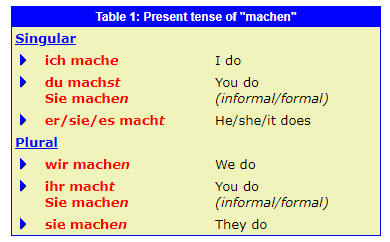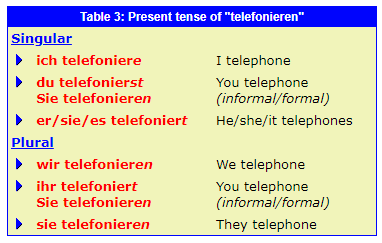The present tense of German verbs is formed from the infinitive of the verb. This is the part of speech which equates to the English "to do", "to speak" etc. In German, the infinitive almost always ends in "-en". To construct the individual forms, we remove the "-en" from the infinitive and add personal endings which link the verb with the subject in terms of person (i.e. first, second or third person) or number (i.e. singular or plural). We say that the verb 'agrees' with the subject, in that German verbs show the person and the number of the subject of the verb by means of their endings.

Unlike in English, there is only form of the present tense in German. There is no continuous present - "ich mache" is used to translate both "I do" and "I am doing".
German pronouns
When learning the German pronouns, note that:
The German pronoun "ich" does not start with a capital letter, unlike its English equivalent "I".
The third person pronouns "er", "sie" and "es" can refer to persons. However they also substitute for all masculine, feminine and neuter nouns respectively, regardless of whether they are persons or things.
Note that the pronoun "sie" can either mean "she" or "they" depending on context. And when it begins with a capital letter "Sie" is the formal form of "you"! Be very careful how you use this pronoun.
Sie or du?
The familiar or informal form "du" is used when talking to relatives, close friends and children.
It does not start with a capital letter.
The plural of "du" is "ihr".
The formal form "Sie" is used when you need to be more polite.
It is the usual form of address when talking to an adult whom you don't know well or at all.
A child would always say "Sie" to an adult outside his or her own family.
"Sie" always starts with a capital letter.
The plural form of "Sie" is also "Sie".
Verbs with a stem ending in -ieren
German verbs whose infinitive stem ends in -ieren have the same endings as regular German verbs.






